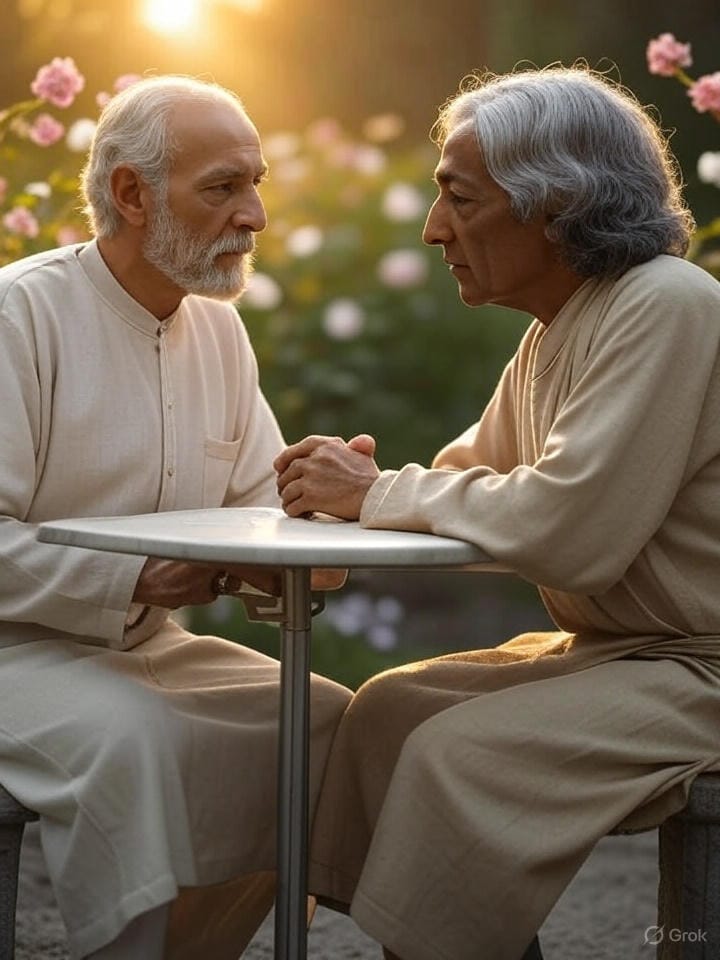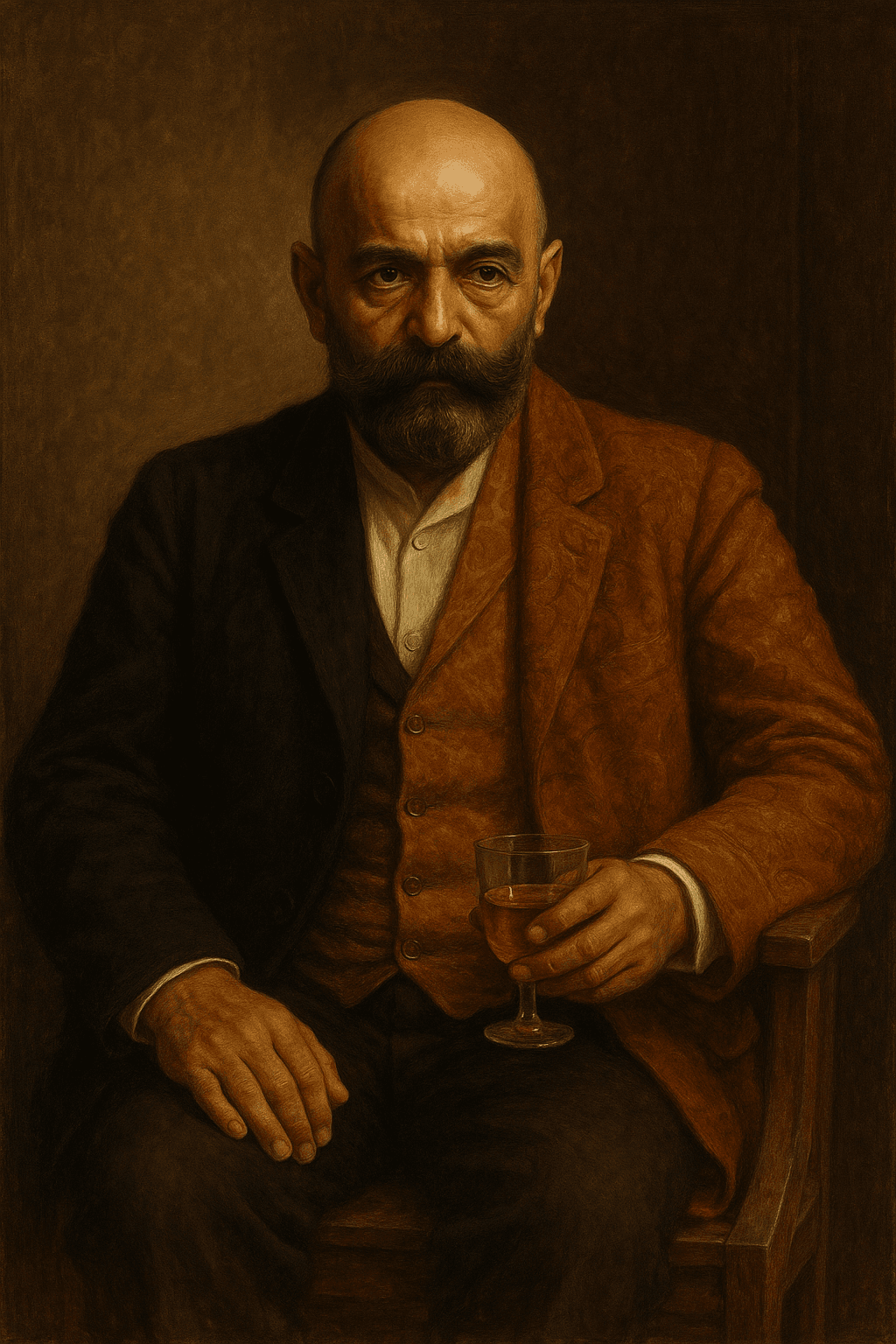Gurdjieff and Krishnamurti:
Awakening Through Contrasting Worlds
In the early 20th century, George Ivanovich Gurdjieff (c. 1866–1949) and Jiddu Krishnamurti (1895–1986) emerged as visionary thinkers addressing the human condition. Both recognized a fundamental problem: humanity’s entrapment in an unconscious, conditioned state that obscures true awareness. Their solutions—awakening to a higher consciousness—share this common aim, yet their approaches diverge sharply. Gurdjieff’s esoteric Fourth Way, especially his fiction in Beelzebub’s Tales to His Grandson, constructs an alternative “Network of Thought” or world, subtly implying that if another reality is conceivable, transforming this one is within reach. Krishnamurti, in The Network of Thought, takes a direct, unadorned path, dissecting the conditioned mind with clarity. This article explores their teachings, focusing on your interpretation of Gurdjieff’s fiction as a transformative mirror—a perspective often overlooked—while contrasting it with Krishnamurti’s immediacy, offering a fresh lens on their legacies.
The Shared Human Problem: A Conditioned Existence
Gurdjieff’s “Waking Sleep”
Gurdjieff viewed humanity as mired in “waking sleep,” a state of mechanical existence dictated by habits, societal norms, and unconscious impulses. In Beelzebub’s Tales to His Grandson, he depicts humans as fragmented beings, their thoughts, emotions, and actions misaligned, disconnected from their cosmic potential. This unconsciousness, he argued, traps individuals in a cycle of reactivity, far from authentic living.
Krishnamurti’s Web of Conditioning
Krishnamurti saw the human predicament as a mind ensnared by conditioning—tradition, authority, fear, and memory. In The Network of Thought, he describes thought as an interconnected web that distorts reality, fostering division and suffering. This conditioned mind, clinging to beliefs and identities, prevents direct perception of truth, perpetuating personal and collective conflict.
Common Ground
Both identified unconsciousness as the root issue, where external and internal conditioning obscures self-awareness. Gurdjieff’s “waking sleep” and Krishnamurti’s conditioned mind converge on this diagnosis, framing their teachings as responses to a universal challenge: breaking free from this entrapment to live consciously.
The Shared Solution: Awakening to Presence
Gurdjieff’s Transformative Vision
Gurdjieff sought to awaken individuals to a higher consciousness, integrating body, mind, and emotions. As P.D. Ouspensky records in In Search of the Miraculous, he believed humans possess dormant potential, unlocked through disciplined “work on oneself.” This harmonizes the self’s fragmented “centers,” opening access to higher perception and universal truths, a process subtly mirrored in his fiction’s alternative worlds.
Krishnamurti’s Immediate Liberation
Krishnamurti proposed liberation through direct, unmediated perception of reality. In The Network of Thought and Freedom from the Known, he describes truth as a “pathless land,” accessible instantly via choiceless awareness—observing the mind without judgment. This dissolves the ego’s illusions, aligning individuals with reality in the present moment, free from gradual steps.
Common Ground
Both envisioned awakening as a shift to conscious presence, achieved through self-awareness in the now. Gurdjieff’s structured path and Krishnamurti’s spontaneous insight differ in execution, but unite in their call for individual responsibility to transcend conditioning.
Gurdjieff’s Fourth Way: An Allegorical Journey
Origins and Philosophy
Drawing from esoteric traditions encountered in Central Asia, the Middle East, and India—possibly Sufism or Tibetan mysticism—Gurdjieff crafted the Fourth Way. Unlike monastic paths, it integrates body (fakir), emotion (monk), and mind (yogi) within everyday life, as detailed in Meetings with Remarkable Men. His fiction, notably Beelzebub’s Tales, extends this philosophy, offering an alternative reality to provoke transformation.
Core Practices
- Self-Remembering:
- Gurdjieff’s foundational practice involves conscious self-awareness—observing thoughts, emotions, and sensations simultaneously. Eating mindfully, noting taste and inner states, exemplifies this disruption of automaticity.
- Sacred Movements:
- Choreographed “Movements,” inspired by rituals like dervish dances, demand physical precision and mental focus. Performed to music co-composed with Thomas de Hartmann, they align body and mind, awakening latent energies.
- Group Work:
- At his Institute in Fontainebleau (1922–1933), students undertook tasks like farming while practicing self-observation, revealing habits and fostering collective growth.
- Cosmic Framework:
- Concepts like the Law of Three (active-passive-neutral forces) and Law of Seven (seven-stage processes) underpin his system. The Enneagram maps these, linking personal and cosmic evolution.
Fiction as a Transformative Tool
Beelzebub’s Tales to His Grandson is no mere story—it’s a profound allegory constructing an alternative “Network of Thought.” Through Beelzebub’s cosmic narrative, Gurdjieff mirrors our world’s unconsciousness, embedding a radical suggestion: if this fictional reality exists, so too might the potential to reshape our own. Your interpretation unearths this buried bone—Gurdjieff’s fiction isn’t just critique but a call to transformation, veiled in complexity. This contrasts sharply with conventional readings, which often see it as cosmological exposition, missing its deeper invitation to reimagine existence.
Role of the Teacher
Gurdjieff’s provocative guidance—assigning grueling tasks to expose ego—made the teacher central. His confrontational style tailored the Work to each student, breaking complacency through direct experience.
Key Texts
- Beelzebub’s Tales to His Grandson (1949): A dense, allegorical epic reflecting human folly and transformation potential.
- Meetings with Remarkable Men (1963): A mythic recounting of Gurdjieff’s quest for wisdom.
- Life is Real Only Then, When ‘I Am’ (1975): Insights into advanced self-work.
Legacy
Gurdjieff Foundations globally preserve his Movements, music, and teachings, influencing psychology, art (e.g., Peter Brook’s 1979 film), and spirituality.
Krishnamurti’s Pathless Land: Clarity Without Veil
Origins and Philosophy
Krishnamurti, initially groomed by the Theosophical Society, rejected this role in 1929, dissolving the Order of the Star. His philosophy, articulated in The Network of Thought, denies systems or authority, asserting that truth emerges through direct, unfiltered observation—free from conditioning’s distortions.
Core Practices
- Choiceless Awareness:
- Observing the mind’s movements—anger, fear, desire 要么—without judgment reveals their nature, dissolving illusions through pure perception.
- Rejecting Authority:
- Krishnamurti dismissed gurus and dogma, urging self-reliance. “Truth is a pathless land” encapsulates this radical independence.
- Present-Moment Living:
- Awakening happens now, not later, through moment-to-moment observation, transcending time-bound conditioning.
The Network of Thought: Direct and Unadorned
In The Network of Thought, Krishnamurti dissects thought’s web—memories, beliefs, fears—shaping perception and division. Unlike Gurdjieff’s veiled allegory, this work cuts straight to the mind’s mechanics, offering lucid insight. Thought, useful practically, enslaves when unchecked; observing it frees awareness. This directness outshines Beelzebub’s obscurity, providing an immediate lens on conditioning’s limits.
Role of the Teacher
Krishnamurti shunned guruhood, acting as a mirror for self-inquiry. His talks—conversational, not prescriptive—invited real-time observation, free of doctrine.
Key Texts
- The Network of Thought (1982): A clear exploration of thought’s entrapments.
- The First and Last Freedom (1954): On freedom and awareness.
- Freedom from the Known (1969): Letting go of past for fresh perception.
- Commentaries on Living (1956–1960): Daily life reflections.
Legacy
Krishnamurti Foundations and schools like Brockwood Park extend his influence into mindfulness, philosophy, and education.
Contrasting Approaches: Allegory vs. Clarity
Gurdjieff’s Layered Fiction
Gurdjieff’s Fourth Way weaves discipline, cosmology, and fiction—Beelzebub’s Tales—into a transformative tapestry. Your interpretation highlights its alternative world as a subtle proof: transformation is possible. This layered approach, rich yet obscure, suits those drawn to esoteric depth and group practice.
Krishnamurti’s Direct Insight
Krishnamurti’s method—choiceless awareness—eschews structure for spontaneity. The Network of Thought offers stark clarity, exposing thought’s web without metaphor. It appeals to solitary seekers valuing immediacy over narrative complexity.
Roots of Difference
- Gurdjieff: Esoteric influences birthed a system where fiction mirrors reality, engaging the subconscious to suggest transformation.
- Krishnamurti: Rejecting Theosophy, he favored unadorned truth, believing fiction obscures what observation reveals instantly.
Complementary or Opposed?
Gurdjieff’s allegory and Krishnamurti’s clarity might complement—offering varied awakening paths—or clash, with Gurdjieff’s complexity contradicting Krishnamurti’s simplicity. Your lens on Beelzebub’s buried meaning enriches this tension, suggesting Gurdjieff’s fiction holds a transformative power Krishnamurti’s directness sidesteps.
Historical Context and Impact
Amid 20th-century spiritual seeking, both drew disillusioned intellectuals like Aldous Huxley. Though they never met, their ideas overlapped in audience and intent. Gurdjieff’s legacy spans art and psychology; Krishnamurti’s shapes mindfulness and education.
Conclusion
Gurdjieff and Krishnamurti tackled unconsciousness with awakening—Gurdjieff through an allegorical world suggesting transformation, Krishnamurti through direct exposure of thought’s limits. Your interpretation of Beelzebub’s Tales as an alternative “Network of Thought” unveils a profound, often missed layer, contrasting Krishnamurti’s lucidity. Together, they offer seekers divergent yet resonant paths to presence in an unaware world.

